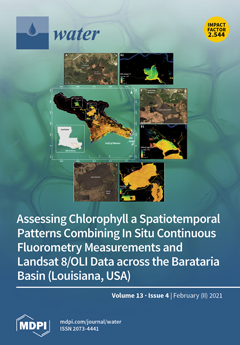In highly water-poor areas, rooftop rainwater harvesting (RRWH) can be used for a self-sustaining and self-reliant domestic water supply. The designing of an optimal RRWH storage tank is a key parameter to implement a reliable RRWH system. In this study, the optimal size of RRWH storage tanks in the different West Bank governorates was estimated based on monthly (all governorates) and daily (i.e., Nablus) inflow (RRWH) and outflow (domestic water demand, DWD) data. In the estimation of RRWH, five rooftop areas varying between 100 m
2 and 300 m
2 were selected. Moreover, the reliability of the adopting RRWH system in the different West Bank governorates was tested. Two-time series scenarios were assumed: Scenario 1, S1 (12 months, annual) and scenario 2, S2 (8 months, rainy). As a result, reliable curves for preliminary estimation of optimal RRWH storage tanks for the different West Bank governorates were obtained. Results show that the required storage tank for S1 (annual) is more than that of the S2 (rainy) one. The required storage tank to fulfill DWD is based on the average rooftop area of 150 m
2, the average family members of 4.8, and the average DWD of 90 L per capita per day (L/c/d) varies between (75 m
3 to 136 m
3) and (24 m
3 to 84 m
3) for S2 for the different West Bank governorates. Further, it is found that the optimal RRWH tank size for the 150 m
2 rooftop ranges between 20 m
3 (in Jericho) to 75 m
3 (in Salfit and Nablus) and between 20 m
3 (in Jericho) to 51 m
3 (in Jerusalem) for S1 and S2 scenarios, respectively. Finally, results show that the implementation of an RRWH system for a rooftop area of 150 m
2 and family members of 4.8 is reliable for all of the West Bank governorates except Jericho. Whereas, the reliability doesn’t exceed 19% for the two scenarios. However, the reduction of DWDv is highly affecting the reliability of adopting RRWH systems in Jericho (the least rainfall governorate). For instance, a family DWDv of 3.2 m
3/month (25% of the average family DWDv in the West Bank) will increase the reliability at a rooftop area of 150 m
2 to 51% and 76% for S1 and S2, respectively.
Full article





